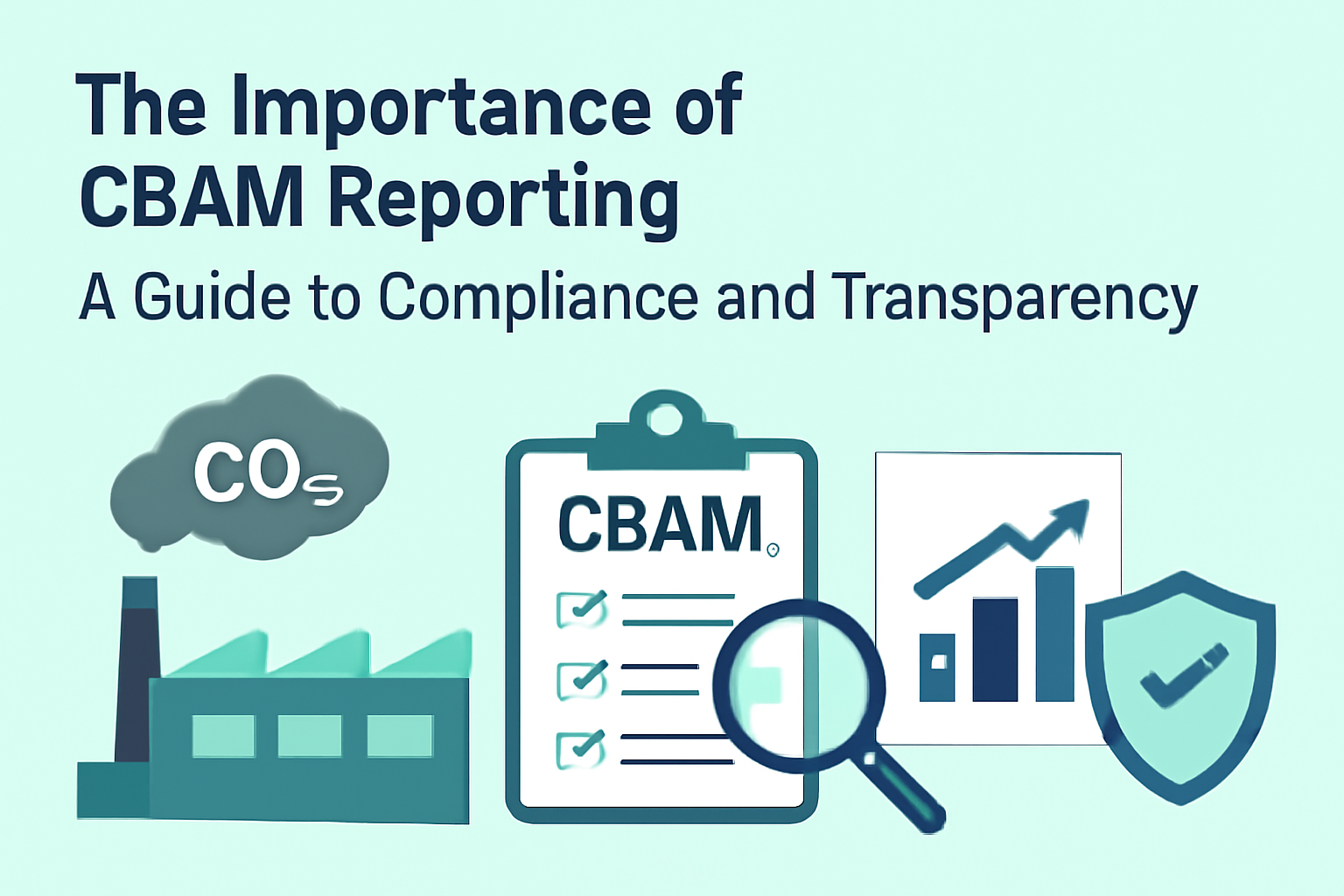The Importance of CBAM Reporting: A Guide to Compliance and Transparency

In today’s globalized world, sustainability and environmental responsibility have become essential components of business practices. Climate change, carbon emissions, and the shift toward cleaner alternatives are issues that impact not just businesses but also the planet as a whole. One of the most recent and significant regulations aimed at curbing carbon emissions is the Carbon Border Adjustment Mechanism (CBAM). This mechanism requires businesses to be more transparent about their carbon footprints, ensuring they contribute to the global effort to reduce carbon emissions. In this blog, we’ll explore the importance of CBAM reporting, its role in compliance, and how it contributes to greater transparency in global trade.
What is CBAM Reporting?
CBAM, or Carbon Border Adjustment Mechanism, is a policy introduced by the European Union (EU) to help curb carbon emissions. This mechanism places a carbon tax on imported goods that do not meet certain carbon emission standards. The purpose of this tax is to make sure that companies in the EU are not disadvantaged by stricter environmental laws, while also encouraging industries in non-EU countries to reduce their carbon emissions.
CBAM reporting refers to the requirement for businesses to report the carbon emissions associated with the products they import into the EU. The goal is to increase transparency, enable the EU to calculate the carbon footprint of imported goods, and ensure that imported products are subject to the same carbon costs as locally produced ones. This transparency is critical in supporting both compliance and the broader objective of reducing global carbon emissions.
Why is CBAM Reporting Important for Global Trade?
The introduction of CBAM reporting has significant implications for global trade. As countries around the world become more focused on reducing carbon emissions, CBAM reporting plays an essential role in ensuring that businesses comply with climate goals. For importers and exporters, this regulation creates a level playing field. It ensures that companies in the EU are not undercut by goods from countries with less stringent environmental policies.
Promoting Accountability and Transparency
CBAM reporting creates a greater level of accountability within global trade. By requiring businesses to disclose the carbon emissions of imported goods, CBAM forces companies to be more transparent about the environmental impact of their operations. This level of transparency is beneficial for consumers, as they are increasingly concerned about the sustainability of the products they buy.
Moreover, CBAM reporting promotes a sense of responsibility within industries. Companies are encouraged to reduce their carbon footprint and adopt more sustainable practices to avoid paying high taxes on their goods. This shift toward sustainability is not just about following a regulation; it’s about positioning businesses as leaders in the fight against climate change.
Enhancing Compliance Across Industries
For businesses operating globally, compliance with CBAM reporting is essential to avoid penalties and taxes. CBAM is not just about paying carbon taxes; it’s about demonstrating a commitment to reducing emissions in line with global standards. By complying with CBAM reporting requirements, companies can show that they are aligning their operations with the European Union’s climate goals.
One of the key aspects of CBAM reporting is the need to calculate the carbon intensity of products accurately. This requires businesses to use reliable data and reporting tools to ensure they are in compliance. Using accurate reporting tools helps mitigate the risk of penalties, as inaccurate data could result in higher taxes or sanctions. Therefore, it’s essential for businesses to invest in robust systems that facilitate accurate emissions reporting and compliance.
CBAM Reporting and the Shift Towards a Sustainable Future
The growing emphasis on CBAM reporting is part of a larger trend toward sustainable business practices. Governments and organizations are increasingly adopting policies and strategies to address climate change, and CBAM is just one example of how businesses are being held accountable for their environmental impact. In fact, many countries are expected to implement similar regulations to curb carbon emissions and promote sustainability.
In the long run, the shift toward carbon transparency will lead to a more sustainable global economy. CBAM reporting encourages businesses to innovate and invest in cleaner technologies, which can help lower emissions across industries. As more companies focus on sustainability and reduce their carbon footprints, the impact of climate change can be mitigated, and the world can move closer to achieving net-zero emissions.
How Businesses Can Prepare for CBAM Reporting
As the deadline for CBAM implementation approaches, businesses need to take proactive steps to ensure they are ready to comply with the new regulations. The first step in preparing for CBAM reporting is understanding the specific requirements that apply to their industry. Importers and exporters will need to gather accurate data on the carbon emissions associated with the products they import into the EU.
Next, businesses should invest in software or systems that can track and report carbon emissions. These tools can help companies calculate the carbon intensity of their products and ensure they meet the necessary reporting standards. Additionally, businesses should work closely with their suppliers to ensure they are also complying with carbon reporting requirements. By collaborating across the supply chain, companies can reduce the overall carbon footprint of their operations.
Another key consideration is the need for businesses to establish internal protocols for carbon reporting. This includes training staff, establishing clear processes for data collection, and ensuring that all relevant information is communicated accurately to the relevant authorities. This approach will help businesses avoid costly mistakes and ensure they are fully compliant with CBAM reporting.
The Role of Technology in CBAM Reporting
As CBAM reporting requires accurate carbon emissions data, technology plays an integral role in ensuring compliance. Today, numerous software solutions and digital tools are available to help businesses track their carbon emissions and generate accurate reports. These tools can automate data collection, calculate carbon intensity, and help businesses comply with regulations efficiently.
Furthermore, advancements in blockchain technology can be used to create transparent and verifiable reports. Blockchain can store carbon emissions data in a secure and immutable way, ensuring that businesses and authorities have access to accurate and tamper-proof information. This use of technology enhances trust and ensures that CBAM reporting is not only accurate but also transparent.
CBAM Reporting Benefits for the Environment
The primary goal of CBAM reporting is to reduce carbon emissions globally, and the environmental benefits are far-reaching. By placing a carbon tax on imported goods, the EU encourages businesses to adopt cleaner practices and technologies to reduce their carbon footprints. This drives global change, as other countries may implement similar regulations to compete in the international market.
Furthermore, CBAM reporting incentivizes industries to improve their supply chains and reduce emissions across the board. As more businesses commit to reducing their carbon intensity, the cumulative effect will help mitigate climate change and create a healthier planet for future generations.
The Challenges of CBAM Reporting
While the benefits of CBAM reporting are clear, there are some challenges that businesses must overcome. One of the primary challenges is the complexity of calculating the carbon intensity of products. The calculation process involves numerous factors, including the type of energy used during production, transportation emissions, and the environmental practices of suppliers.
Moreover, many businesses may lack the necessary data or infrastructure to track carbon emissions effectively. This can be particularly challenging for small businesses or those that operate in regions with limited access to technology or resources. However, as technology improves and more resources become available, these challenges will likely become easier to navigate.
Conclusion: Embracing CBAM Reporting for a Sustainable Future
CBAM reporting is more than just a regulatory requirement—it’s a powerful tool in the fight against climate change. By promoting transparency, accountability, and sustainability, CBAM reporting encourages businesses to adopt cleaner practices and contribute to a more sustainable global economy. While there are challenges involved, the long-term benefits of CBAM reporting are undeniable. By embracing this change, businesses can help pave the way for a greener, more sustainable future.
For businesses seeking to stay ahead of the curve, it’s essential to invest in tools and systems that support CBAM reporting. By doing so, they can not only comply with the regulations but also demonstrate their commitment to sustainability and environmental responsibility.
For more details on CBAM reporting and how to ensure compliance, visit https://cleancarbon.ai/.

